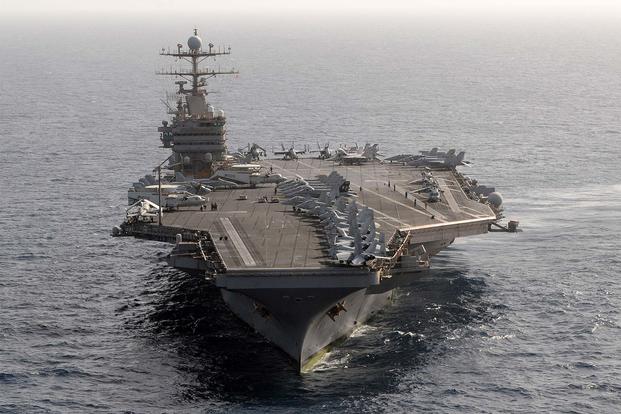ABOARD THE USS ABRAHAM LINCOLN -- In driving rain and rolling seas, the F/A-18E Super Hornets and EA-18G Growlers from Strike Fighter Squadron 25 and Electronic Attack Squadron 140 take off and land on the flight deck of the carrier Abraham Lincoln, training for a historic deployment with the Navy's newest combatant command, the 2nd Fleet.
The around-the-clock flight operations are part of Carrier Strike Group 12's composite training exercise, or COMPTUEX, taking place this month to ensure that the group is ready to deploy later this year.
According to Lincoln commander Capt. Putnam Browne, the crew spent the past year "kicking off the rust" of the ship's Refueling and Complex Overhaul, completed in 2017, and is preparing for deployment as well as a homeport move to San Diego.
"People typically say COMPTUEX is much harder than deployment, but that's the way it should be. Just like when you train for a sports evolution, you should over-train before the event happens," Browne said.
The exercise allows the ships in the carrier strike group -- Destroyer Squadron 2, consisting of the guided-missile destroyers Bainbridge, Nitze, Mason and Gonzalez; the guided-missile cruiser Leyte Gulf; and the Spanish navy frigate Mendez Nunez -- to work with the carrier and the air wing to test their capabilities, including air warfare, surface and subsurface warfare, and electronic attacks.
The standards are high, and if the group doesn't meet them, they won't be certified, said Vice Adm. Andrew Lewis, commander of 2nd Fleet and the exercise evaluator.
"I'm not obligated to make anybody feel good. If I don't think they are meeting the mark to deploy anywhere on the globe, I'm going to tell [U.S. Fleet Forces Command]. It's my responsibility," Lewis said.
The 2nd Fleet was reactivated on Aug. 24, 2018, to oversee operations and administration for naval assets and attached Marine Corps units to the East Coast and North Atlantic. Its missions include homeland defense and natural disaster response, as well as countering Russian and Chinese regional presence.
"It's a global competition," Lewis said, addressing the Navy's reasons for standing up the new command. "What's happening in the Arctic and the amount of traffic in the Atlantic, the ability for us to be able to provide free trade and use of sea lines of communication is being threatened. It's a competitive space."
Carrier Strike Group 12 will deploy while the fleet is working toward full operational capability, expected by the end of the year.
On board Abraham Lincoln, commanders wouldn't discuss the timeline for deployment or the COMPTUEX's training scenarios. Tight lips are part of the Navy's "dynamic force employment" efforts, a strategy designed to move forces around without telegraphing operational intent to potential adversaries.
Last year, the Harry S. Truman Carrier Strike Group became the first to deploy with the new strategy, departing for a standard deployment, then returning to port three months later before leaving again for operations near the Arctic Circle -- a place a carrier group hadn't gone since the early 1990s. The idea is to create a surface Navy that is more agile and unpredictable, service officials said.
What is known is that the Abraham Lincoln Strike Group will deploy, and it will move some time this year to San Diego, to replace the carrier Carl Vinson, also a Nimitz-class vessel, which is heading to Bremerton, Wash. The carrier John C. Stennis will leave Bremerton and move to Norfolk, Virginia, for a mid-life refueling and overhaul similar to the one the Lincoln just completed.
According to the Lincoln's leadership, efforts are well underway to move a portion of the 6,000-member crew and families to San Diego, where the ship is expected to end its deployment.
"We have ... an effective date, which is 31 October 2019. All dependent travel and escort travel with the members is to be completed within 180 days after the effective date," Chief Personnel Specialist Michael Rangel said.
It's a lot for a ship's crew to handle -- a newly refurbished vessel, homeport change, new combatant command, and an unpredictable deployment schedule. But senior leaders say the crew, some of whom have never even made a port call, are readying for the challenge.
"COMPTUEX gives us the ability to train, and to repeat, and collect the data on how we are doing, identifying our strengths, building on our strengths and identifying areas that we need to work on. And then we continue to work those to improve so we are in our peak condition, ready to go," said Rear Adm. John Wade, commander of Carrier Strike Group 12.
The sailors are excited to be training for deployment, Wade said. "It's always a sacrifice, not only for the sailors and the families, when we operate at sea, but this is what we volunteered for -- an opportunity to serve our country and make a difference. As you engage with the sailors, that becomes very clear."
And the Atlantic Ocean is doing its part in providing the crew the best training it can offer. In the first three days of COMPTUEX, the Lincoln operated in 5-foot seas, 15- to 20-knot winds, rain and darkness.
"The weather is not cooperating but, in many respects, it's providing training for the full spectrum of operations. If it was beautiful weather out there, we wouldn't be getting the level of training we need," Browne said.
-- Patricia Kime can be reached at Patricia.Kime@Military.com. Follow her on Twitter @patriciakime.












